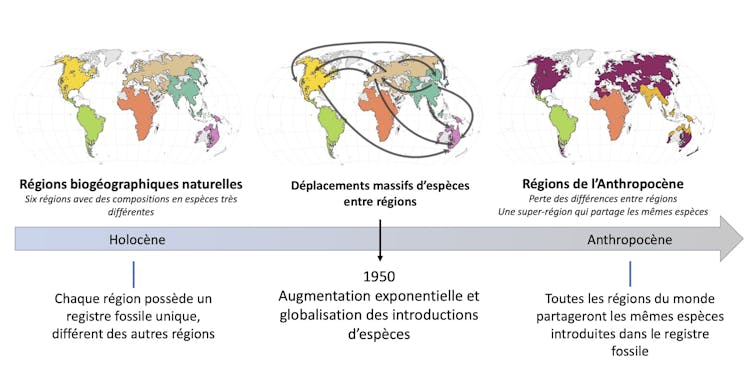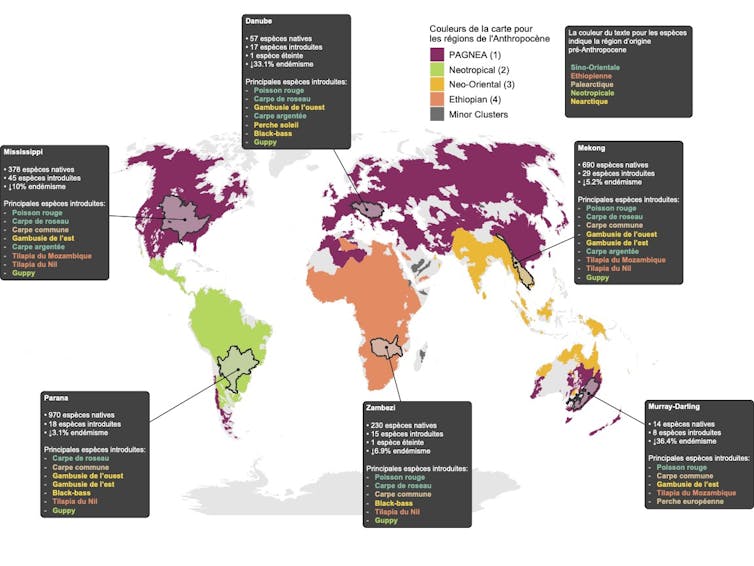Have we entered the geological era of the Anthropocene, an “epoch of man” where humans have become the main force of planetary change, surpassing natural geological forces? The question is debated by the scientific community, in particular within the International Commission on Stratigraphy, which has been working on the subject since 2009. Last July, the sedimentary record expected to serve as a reference and define the Holocene transition to the Anthropocene had been selected in Ontario, Canada .
What are the clues that can testify to the entry into the Anthropocene? Geologists and paleontologists are accumulating all kinds of evidence : visible traces in sedimentary layers such as plastic pollution or radioactivity, or even changes in fossils due to the biodiversity crisis. So some researchers even suggest considering, as a marker, the bones of the chickens we eat , which will become fossils within a few million years.
But this is not the only way in which our species has disrupted planetary biodiversity. With an international team, which notably brought together the BOREA laboratory of the National Museum of Natural History (MNHN), the CNRS and the IRD, we showed how human societies have redesigned the geography of freshwater fish biodiversity.
We postulate that these are major changes, which constitute new evidence of the entry into the Anthropocene. Our work was published on November 17 in the journal Science Advances .
How plate tectonics isolated freshwater fish
To fully understand these results, we need to go back a little into the history of the planet. The 11,000 species of freshwater fish that populate the planet are confined to their freshwater environments: rivers and lakes. They do not tolerate salt water, and for them, hills, mountains, or oceans represent insurmountable barriers.
These are natural geological forces that have always dictated their evolution throughout Earth's history. Plate tectonics, by isolating continents, separated freshwater fish into six major geographic regions . Each region evolved in isolation over tens of millions of years, until it had a unique suite of species.

These large regions are called “biogeographic regions”, and they all have an exceptionally high rate of endemism – that is to say a proportion of species that are found nowhere else – of the order of 96.7 to 99.7%. This figure is much higher than in other groups of vertebrates.
Each region therefore has its own freshwater fish, and for millions of years, when they die, these fish form fossil remains that are not found elsewhere in the world.
Our societies have changed the rules of the game
This quiet evolution orchestrated by plate tectonics has very recently been disrupted by human activities. For the first time in Earth's history, it became possible for freshwater fish to cross oceans and mountains.
In the 19th century, “acclimatization societies” set themselves the objective of establishing populations of familiar fish in the colonies, and of exotic fish in European waters. These companies have thus introduced numerous European species into Australia and New Zealand, or have introduced North American species into Europe or Russia.
Other reasons quickly emerged to justify the introduction of species outside their native areas. Biological control for example, with the introduction of small North American gambusias throughout the world to eat mosquito larvae. The construction of canals connecting different rivers has also allowed species to reach previously inaccessible areas.

But it was especially in the middle of the 20th century that we began to massively move species between continents. From 1947, we observed an exponential acceleration of introductions , with a globalization of the origins and destinations of introduced species. This phenomenon can be explained by the explosion and globalization of trade from this date.
The species were then transported between continents for aquaculture or for the ornamental trade (aquarium trade) , and too often they escaped, accidentally or intentionally. For example, African tilapia were introduced around the world for aquaculture, and quickly escaped from farms to establish themselves in new areas. Aquarium fish such as guppies, goldfish and even carp have also escaped to colonize natural environments.
In parallel with these accidental introductions, humans have voluntarily introduced many species into wild environments, for recreational fishing or subsistence fishing. The use of exotic fish as bait for fishing or to stock natural environments has developed and caused numerous introductions throughout the world, such as the Asian gudgeon or the sun perch in Europe.
In total, 453 species were introduced outside their natural area, between continents, which has profoundly reshaped the geography of freshwater fish biodiversity.
Humans recreated Pangea
To study the consequences of these introductions, we compared the natural geography of biodiversity versus the geography modified by the introductions with the same method of analysis, called “bioregionalization” .
Our results were clear. We have observed the unprecedented emergence of a super-region that covers all continents: North America, Europe, East Asia, Oceania, and a small part of Africa and South America. This new distribution clearly illustrates the link between introductions of exotic species and international trade, because it connects the countries of the world with the greatest trade .
[ More than 85,000 readers trust The Conversation newsletters to better understand the world's major issues . Subscribe today ]
We called this super-region “PAGNEA” for Pan-Anthropocenian Global North and East Asia. The acronym PAGNEA is deliberately evocative of Pangea, which is the last supercontinent on the planet to have existed more than 200 million years ago.
At the time, organisms were able to disperse throughout Pangea, because the oceans did not yet constitute a barrier. What the PAGNEA region shows us today is that human societies are artificially recreating the conditions of Pangea, allowing organisms to disperse across all continents.
A standardization of fossil layers
Before human activities, each continent had its unique fossils, which could not be found anywhere else. From now on, because of the introductions, we will have fossils shared between the different continents of the PAGNEA region. The map below illustrates expected changes in fossil layers around the world, and in particular for several notable watersheds.

These changes in the distribution of fossils on a planetary scale are a determining criterion for the recognition of the Anthropocene. This is the first mapping to show such magnitude in the expected changes, while using a large body of quantitative data on the distributions of freshwater fish.
This discovery will therefore probably contribute to the work of the Anthropocene Working Group , which is studying the evidence accumulated by scientists and will decide in the future to ratify the transition to the Anthropocene.
Message to paleontologists of the future
Beyond the Anthropocene, this demonstration of the magnitude of the effect of species introductions on a global scale should push us to reflect on two major consequences.
First of all, the introduction of non-native species poses the risk of creating new biological invasions whose consequences can be dramatic for ecosystems and economies , especially since the main introduced species are very abundant and already known. to be invasive.
It is therefore absolutely necessary to prevent new introductions , with particular concern about emerging threats such as online trade in live species .
The second reason is almost philosophical: it helps us realize that our actions, on a very short time scale – barely 70 years – will have visible repercussions in the fossil layers which will be studied by the paleontologists of the future. But these impacts will not only be significant, but also irreversible, because we are in the process of lastingly altering the evolutionary trajectory of biodiversity on the planet by creating new evolutionary starting points for the lineages of the future.
In several million years, biodiversity will still bear the evolutionary imprint of an era when the dispersal of organisms once again became possible between continents. The essence of this era, of our era, lies there: the natural geological forces have been surpassed by a new force of planetary change, the human species. ![]()
Boris Leroy , Lecturer in ecology and biogeography, National Museum of Natural History (MNHN)
This article is republished from The Conversation under a Creative Commons license. Read the original article .
